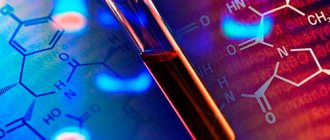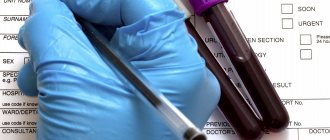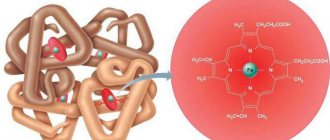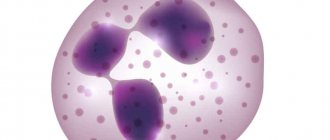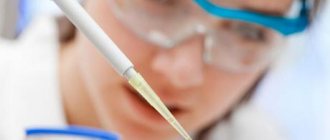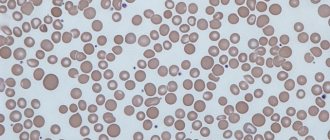Prothrombin is a proenzyme synthesized in the liver under the influence of vitamin K. This glycoprotein is one of the main indicators of a hemostasiogram (clotting test).
Being a precursor of thrombin (a protein that stimulates the process of thrombosis), prothrombin in a blood test reflects the state of the entire coagulation system. Prothrombin is also called the second factor of hemostasis. Monitoring prothrombin values allows you to assess the risk of developing hypercoagulation or bleeding, as well as diagnose some pathologies of the liver and gastrointestinal tract.
The initiation of thrombus formation in response to a violation of the integrity of the vascular wall occurs along the external coagulation pathway.
The internal pathway of hemostasis is responsible for the formation of a blood clot in areas with slow blood flow or an abnormally changed vascular wall. For reference. The importance of the prothrombin test also lies in the fact that it allows one to evaluate both pathways of hemostasis (external and internal).
For a comprehensive study of hemostasis, the study is most often used:
- prothrombin time (PT);
- activated partial thromboplastin time;
- platelet count;
- quantitative determination of fibrinogen.
What is prothrombin, what are its functions?
Thrombin is the end product of prothrombin conversion reactions
Prothrombin is a plasma protein involved in the coagulation process. Its level is an important factor for the optimal functioning of the hemostatic mechanism, therefore, in the diagnosis of hemocoagulation and various diseases, prothrombin is given much attention.
Prothrombin originates in the liver; a necessary element for its formation is vitamin K. Having penetrated the bloodstream, the protein circulates in an inactive state until the integrity of the vessel is damaged. Once this happens, a chain of reactions is set in motion that prevents blood loss. All coagulation factors sequentially activate each other; factor X and factor V, in the presence of calcium ions, form a complex with tissue phospholipids that affects prothrombin. Prothrombin is converted to thrombin, which breaks down the next factor fibrinogen, forming a blood clot.
How to increase prothrombin
If studies have shown that prothrombin according to Quick is low, the attending doctor will give recommendations for its correction. He will recommend including natural foods containing vitamin K in your diet. It will be necessary to normalize your water balance, optimize the consumption of clean water, the norm must be increased to two liters per day.
Eat foods that help improve blood clotting. These include cabbage (cauliflower and regular), spinach, carrots, corn, walnuts, bananas, red berries. In such cases, buckwheat porridge, animal fats, legumes, liver, and white bread are useful. These products should be present on the menu every day. At the same time, the diet should be full of other vitamins and microelements; you will only supplement it with the listed products.
In order to prevent bleeding, the doctor recommends eliminating decoctions based on nettle, tansy and yarrow.
Indications for the study
Liver function test - indication for analysis
The study is carried out both during a routine assessment of hemostasis and when diagnosing pathologies of internal organs and the circulatory system.
Analysis is prescribed in the following cases:
- examination during pregnancy;
- preoperative and postoperative diagnostics;
- study of liver functions, pathology of liver tissue;
- thrombosis;
- bleeding;
- diseases associated with a lack of coagulation factors;
- pre-infarction and post-infarction conditions;
- disorders in the circulatory system;
- monitoring of anticoagulant therapy.
Reduced rate
Low prothrombin is accompanied by hypocoagulation, which occurs due to reasons such as:
- Use of blood thinning medications.
- Fibrinogen deficiency (acquired, congenital).
- Liver pathologies.
- Deficiency of certain coagulation factors (congenital).
- Vitamin K deficiency.
If hypocoagulation is present, the following diseases can be suspected in a patient:
- Hypovitaminosis.
- Prothrombin deficiency.
- Gastrointestinal pathologies.
- Dysbacteriosis.
Preparing for analysis
It is not recommended to perform diagnostic procedures before the test
For correct results, it is recommended to follow the rules:
- The last meal should be completed 12 hours before the test.
- Alcohol is excluded the day before the test, smoking - at least 1 hour.
- You should not take medications on the day of the test; if you took medications in the previous days, you should provide a list of them to your doctor.
- You can drink only clean water before the procedure, excluding tea, coffee, and juices.
- Other studies (ultrasound, x-ray) should be carried out after blood collection.
- It is necessary to limit physical and emotional stress.
- Women are recommended to take the test in the second phase of the menstrual cycle.
Decoding the analysis: what do indicators that deviate from the norm indicate?
In the case when the obtained analysis results are lower or higher than generally accepted norms, it means that there are certain disorders in the body . The transcript is usually provided to the patient in the form of a table, which, in addition to indicating the percentage, describes the reasons for deviations from the norm.
A low prothrombin index indicates the following abnormalities:
- lack of vitamin K;
- disorders of the liver and pancreas;
- long-term use of medications that affect blood clotting.
ATTENTION! A low prothrombin index indicates an increased risk of bleeding. The lower the indicator, the greater the risk of developing heavy bleeding with a fatal outcome.
Symptoms of a low prothrombin index may include indicators characteristic of diseases of the liver and gastrointestinal tract. In this case, weakness, weight loss and changes in taste preferences are noted. But the most important indicator is heavy bleeding from a minor cut. Having an abrasion on the elbow, you can lose up to 300 ml of blood when the prothromine index is low.
When the transcript contains elevated indicators, this indicates the following health problems:
- increased concentration of heparin, an active clotting inhibitor;
- increased synthesis of vitamin K;
- the presence of thromboembolism and thrombophlebitis;
- heart problems (heart attack and pre-heart attack);
- formation of malignant neoplasms.
ATTENTION! An increased rate indicates that the blood is becoming too viscous, resulting in a decrease in its throughput and transport capacity.
Any deviations from the norm should be investigated in detail. A decreased or increased prothrombin level is a reason to undergo a comprehensive examination to identify the true causes of what is happening.
Methods for determining prothrombin levels
The Quick method is most often used in the diagnosis of prothrombin
Prothrombin is examined using a number of tests:
- Prothrombin time (PT);
- Prothrombin index (PTI);
- Prothrombin ratio (PR);
- Prothrombin according to Quick;
- Prothrombin time expressed as INR.
One of the most common determination methods accepted throughout the world is the Quick method. It has an advantage over other tests (for example, PTI), since it is more standardized and also has a high sensitivity to lack of factors. PT indicators according to Quick are presented as percentages, which makes it possible to quantitatively characterize disturbances in the process of blood coagulation.
In laboratory conditions, the mechanism of the extrinsic coagulation pathway is simulated by adding thromboplastin and a calcium mixture to the test plasma. The time during which the clot was formed is calculated in seconds, and the obtained values are plotted using a calibration graph. To construct the graph, PT values in diluted samples of control plasma, which is a mixture of citrate plasma from healthy donors, are used. That is, the ratio of the activity of the prothrombin complex to the control sample is calculated.
What does “according to Kwik” mean?
The expression “Quick”, often used in hematology, appeared in honor of the developer of the method of testing blood for prothrombin.
This is an American physician and physiologist Armand James Quick (1894 – 1978). Armand Quick developed three different tests in the course of his research, but of interest to us is his one-step test for the amount of prothrombin present in the blood plasma and the determination of the clotting time of prothrombin.
It was this test that made it possible to widely use the expression “according to Quick.” We must pay tribute that it is the Armand Quick test that gives the most accurate picture of the ability of blood to clot.
Indicator norm
Normal values depend on the laboratory
Standard values are 70 - 120%. Indicators may vary depending on the laboratory, so you need to check your result with the norm indicated on the analysis form. In women during pregnancy, the rate may increase due to changes in the blood coagulation system.
Decoding, norm according to Kwik
When deciphering the analysis, researchers find out the PTI and the time during which the folding occurs, this indicator is indicated in seconds. A graph is drawn up for the result, indicating the percentage of clotting readings. Each laboratory interprets the result in its own way; this may depend on the agents and the quality of the equipment, on how the patient used the drugs, on the characteristics of his treatment, on individual standards.
If prothrombin according to Quick is prescribed, the norm will be established, regardless of gender. The indicator is affected only by the state of the body. Normal prothrombin time is a period of 9-12 seconds, PTI in an adult is 82-142%.
This indicator is important during pregnancy; even with minor changes, the woman should be hospitalized. Deviations from the norm of prothrombin indicate disturbances in the body.
Increased prothrombin levels: causes
A level above normal indicates the following factors:
- congenital diseases associated with a lack of coagulation factors;
- acquired deficiency of coagulation factors due to liver disease;
- lack of vitamin K due to intestinal dysbiosis or other gastrointestinal disorders;
- chronic diffuse glomerulonephritis;
- anticoagulant therapy;
- the presence of antibodies to coagulation factors, mainly to factor VIII;
- oncological neoplasms.
Increased prothrombin in men and women
Prothrombin in men and women over 45-50 years of age is often increased - more than 142% according to Quick. Hypercoagulation can be caused both by the presence of vascular diseases and by temporary factors. The latter include:
- Imbalance of vitamin K, which interferes with the proper synthesis of prothrombin in the liver, where it is normally formed;
- Chronic liver diseases and disorders of its functioning, which also interfere with the normal synthesis of prothrombin;
- Congenital anomalies: deficiency of blood coagulation factors II, V, VII, X;
- The presence of a heparin inhibitor in the coagulation mechanism;
- Nephrotic syndrome, amyloidosis (deposition of a special pathological protein in organs);
- Taking antiseptic, laxatives, anabolic agents, hormonal drugs, nicotinic and acetylsalicylic acid, quinine, quinidine.
Increased prothrombin not due to the above factors indicates the presence of serious diseases. Thus, the diagnostic search is based on the following nosologies:
- Thromboembolism (blockage of blood vessels with blood clots);
- Polycythemia (increased number of red blood cells in the blood, including in connection with oncological processes);
- Oncological diseases: leukemia, cancerous tumors of various locations;
- Pre-infarction state of the body;
- Myocardial infarction.
Prothrombin in women may be increased due to long-term use of hormonal contraceptives, especially with an increased dosage of the estrogen component (from 30 to 50 mcg per tablet).
If the patient has serious vascular diseases, birth control pills should be discontinued. It is possible to switch to local hormonal drugs (suppositories, vaginal ring).
Diet does not significantly affect blood clotting. You can reduce the Kwik score by several percent by adding “oxidizing” foods to your daily menu. An increased result is caused by a lack of fermented milk products, red and black berries, citrus fruits, fatty fish and the amount of water drunk in the diet.
Reduced prothrombin level: reasons
Heart disease may reduce prothrombin levels
The level below standard values is caused by the following reasons:
- thrombosis of various locations;
- cardiovascular disorders;
- injuries, consequences of surgery;
- taking hormonal medications, including oral contraceptives;
- oncological neoplasms;
- DIC syndrome;
- pregnancy.
Increasing values
- Cardiovascular diseases: myocardial infarction and previous conditions, cerebral stroke;
- Dehydration due to increased blood viscosity;
- Hyperglobulinemia (increased levels of proteins in the blood);
- Thromboembolism (blockage of the lumen of a vessel with a blood clot) and related conditions;
- The body's production of antihistamines;
- Oncological processes (for example, leukemia);
- Polycythemia (benign formations of the circulatory system);
- Congenital or acquired deficiency of coagulation factors;
- Liver diseases (cirrhosis);
- Renal dysfunction: amyloidosis (pathology of protein metabolism), nephrotic syndrome (generalized edema);
- Secretion of autoimmune antibodies directed against coagulation factors;
- Acute vitamin K deficiency due to diseases of the pancreas (chronic pancreatitis, cancer), cholestasis (stagnation of bile in the liver), malabsorption syndrome (impaired absorption in the intestines), dysbiosis, etc.;
- DIC syndrome (coagulation disorder in small vessels);
- Afibrinogenemia, hypofibrinogenemia, dysfibrinogenemia (reduced secretion of fibrinogen, its defective forms);
- The presence in the blood of elements that inhibit the coagulation process (fibrin breakdown products, heparin and others);
- Hypertension (high blood pressure);
- Congenital diseases affecting hemostasis (hemophilia A and B, von Willebrandt disease);
- Increased plasma concentrations of antithrombin, antithromboplastin.
Also, prothrombin time lengthens during treatment:
- indirect anticoagulants;
- hormones (including oral contraceptives);
- anabolics;
- steroids and corticosteroids;
- aspirin;
- antibiotics;
- laxatives;
- nicotinic acid;
- quinine;
- diuretics and other drugs that slow down the effect of vitamin K.
Decoding the analysis results
Increased prothrombin levels - risk of bleeding
An increased level indicates an increase in clotting time and provokes a tendency to bleeding. If a vessel is damaged, the hemostasis system is not able to create an obstruction in a timely manner, which can lead to bleeding. The inability of blood to clot naturally in severe forms is manifested by a tendency to internal bleeding, as well as spontaneous hemorrhages.
The well-known disease hemophilia, which is characterized by a congenital deficiency of one of the coagulation factors, in past centuries was the cause of death due to the inability to prevent bleeding. Today, there are many methods and means for correcting elevated PV levels, the main thing is to stop the development of pathologies that provoke an increase in blood clotting time in a timely manner.
A reduced level means that the blood’s tendency to form blood clots, that is, thrombophilia, increases. This condition can lead to thrombosis of veins, arteries and capillaries, which can lead to the development of pathologies of internal organs. Blood clots blocking blood vessels prevent the circulatory system from delivering oxygen throughout the body and releasing carbon dioxide from tissues. The formation of clots in the portal vein provokes liver failure, in the arteries of the brain - a stroke, and so on.
Thrombophilia is a common disease; in various countries, the number of people suffering from this phenomenon ranges from 15 to 40%. Modern medicine has the means to combat the disease, but it must be identified as early as possible. Therefore, it is so important to monitor the state of hemostasis of your circulatory system.
decoding according to hemostasiogram
A coagulogram during pregnancy always shows increased blood clotting. This is a physiological norm for pregnancy. There are several factors in hemostasis that can be determined by laboratory methods. To study the phase of vascular-platelet (primary) hemostasis, the following are determined: bleeding time, platelet number, platelet adhesive and aggregation abilities, blood clot retraction and some other specific indicators. Methods for studying coagulation (secondary) hemostasis include coagulation time, prothrombin index (PTI), determination of thrombin time, determination of the amount of fibrinogen, activated partial thromboplastin time (APTT), etc.
Bleeding time (BT) This is the interval between the time the flesh of the finger is punctured and the bleeding stops. Normally, bleeding stops 2-3 minutes after the puncture and gives an idea of the function of platelets. Prolongation of bleeding time is observed with: hereditary thrombocytopenia (hereditary decrease in the number of platelets); vitamin deficiency C; long-term use of aspirin and other medications that reduce blood clotting (anticoagulants). Adhesion, aggregation and retraction of platelets Adhesion is the property of platelets to adhere to the damaged vessel wall. The normal adhesiveness index is 20-50%. A decrease in the index indicates a decrease in the ability to adhere to the damaged area and is observed in: renal failure; acute leukemia; some specific diseases. Aggregation is the ability of platelets to connect. Spontaneous aggregation is normal - 0-20%. Increased aggregation occurs with: atherosclerosis; thrombosis; myocardial infarction; diabetes mellitus. Reduced platelet aggregation occurs when the platelet count decreases or certain specific diseases. The definition of blood clot retraction is the process of contraction, compaction and release of blood serum from the initial blood clot. The normal retraction index is 48-64%. Its decrease occurs when the number of platelets decreases. Blood clotting time This is the interval between blood collection and the appearance of a fibrin clot in it. The norm for venous blood is 5-10 minutes. The norm for capillary blood: start 30 seconds - 2 minutes, end 3-5 minutes. An increase in clotting time occurs due to a lack of a number of coagulation factors in the blood plasma or the action of anticoagulants (medicines that reduce blood clotting). It happens with hemophilia or liver diseases. A decrease in clotting time is observed when taking oral contraceptives or after heavy bleeding.
Prothrombin index (PTI) and thrombin time Prothrombin is a complex protein, one of the most important indicators of a coagulogram, characterizing the state of the blood coagulation system. It is a precursor to thrombin (a protein that stimulates blood clot formation). Prothrombin is synthesized in the liver with the participation of vitamin K. Based on the analysis of prothrombins, the doctor can evaluate the work and identify diseases of the liver and gastrointestinal tract. To characterize the blood coagulation system, prothrombin analysis is the most important test included in the hemostasiogram. Prothrombin time is the time of formation of a fibrin clot in plasma when calcium chloride and thromboplastin are added to it. Prothrombin time is expressed in seconds. Normally it is 11-15 seconds. However, the prothrombin index (PTI) is more often calculated - this is the ratio of the clotting time of control plasma (plasma of a healthy person) to the clotting time of the patient's plasma. Expressed in %. Normally, the range of fluctuations in the prothrombin index is 93-107%. The synthesis of factors of the prothrombin complex occurs in liver cells; in liver diseases, the number of factors decreases, and the prothrombin index, to a certain extent, can serve as an indicator of the functional state of the liver. An increase in PTI shows an increase in coagulability and the risk of developing thrombosis, but can be observed normally in the last months of pregnancy and during taking oral contraceptives. A decrease in the prothrombin index indicates a decrease in blood clotting properties. Vitamin K is necessary for the formation of prothrombin complex factors. With its deficiency, impaired absorption of the vitamin in the intestine due to enterocolitis and dysbacteriosis, the prothrombin index may also decrease. Large doses of acetylsalicylic acid and diuretics such as hypothiazide cause a decrease in the prothrombin index. Thrombin time is the time during which fibrinogen is converted to fibrin. Normally it is 15-18 seconds. An increase in thrombin time occurs with severe liver damage or congenital fibrinogen deficiency. A shortening of time indicates an excess of fibrinogen or the presence of paraproteins (special proteins from the class of immunoglobulins). This indicator must be monitored during treatment with heparin and fibrinolytics. Fibrinogen is a protein synthesized in the liver and, under the influence of a certain blood factor, turns into fibrin. Donating blood for fibrin is usually prescribed if you want to: determine the pathology of blood clotting; conduct preoperative examination and postoperative period; conduct a pregnancy examination; control blood during inflammatory processes. The normal level of fibrinogen in the blood is 2-4 g/l. An increase in fibrinogen indicates an increase in coagulability and the risk of blood clots and is noted: at the end of pregnancy; after childbirth; after surgical interventions; with pneumonia; for acute inflammatory and infectious diseases (influenza, tuberculosis); on the first day of stroke; with myocardial infarction; with decreased thyroid function (hypothyroidism); for burns; when taking estrogens and oral contraceptives; for some specific diseases. A decrease in fibrinogen is observed in: severe forms of hepatitis or cirrhosis of the liver; serious disorders in the blood coagulation system; toxicosis of pregnancy; lack of vitamin C or B12; taking anabolic hormones, androgens, anticoagulants (streptokinase, urokinase), fish oil. Activated partial thromboplastin time (aPTT) - This is the time during which a blood clot forms after calcium chloride and other substances are added to the plasma. APTT is the most sensitive indicator of blood clotting. The normal APTT is 30-40 seconds on average. An increased activated partial thromboplastin time can be observed in liver diseases and vitamin K deficiency. If the level of at least one of the coagulation factors is reduced by 30-40% of the norm, then the APTT level also changes. A slowdown in blood clotting due to an increase in the duration of the APTT occurs with a decrease in blood clotting , hemophilia and some rarer diseases.
material taken from here
Prothrombin during pregnancy
With each trimester of pregnancy, prothrombin levels decrease
A woman's body undergoes many changes during pregnancy to promote optimal childbearing. The hemostasis system increases blood clotting to prevent possible bleeding, as well as to prevent critical blood loss during childbirth. With each trimester, clotting time indicators decrease, that is, a clot forms faster.
Previously, they tried to correct this condition with anticoagulants. But in today's medical practice, such drugs are used only in cases where coagulation rates exceed the permissible high values and can provoke delayed fetal development, premature aging of the placenta, fetoplacental insufficiency, and spontaneous abortion.
If a pregnant woman has a decreased PV index, there is a risk of bleeding, miscarriage, or placental abruption. But based on one analysis, a diagnosis cannot be made, both with high and low values, it will be necessary to undergo additional studies that will help to find out the cause and eliminate it in time.
Analysis indicators
As mentioned earlier, Quick analysis allows you to determine two important indicators:
- prothrombin index - an indicator calculated by relating the normal results of prothrombin time to the results of the test blood sample;
- prothrombin time is the time in seconds during which prothrombin proteins are able to influence plasma coagulation.
Prothrombin analysis according to Quick allows you to determine prothrombin time and prothrombin index by constructing a control graph that displays coagulation indicators as a percentage during two phases of hemostasis.
Thrombin time is normal
To measure thrombin time, the following reference values are accepted:
Factors influencing the result
Sometimes the results may be distorted. There are a number of reasons for this:
- Age (in newborns, thrombin time is normally prolonged);
- Violations of the rules for preparing for a coagulogram;
- Violations of the algorithm for blood collection, its transportation and storage;
- Incompetence of laboratory workers;
- Taking interfering drugs;
- Transfusion of frozen plasma shortly before the test (hides quantitative and structural fibrinogen abnormalities);
- Menstruation (reduces clotting rates);
- Acute febrile syndrome in a patient during venous blood sampling;
- Recent injuries, wounds, burns, surgery.
Prothrombin is increased
An increased level of prothrombin in the blood indicates that blood clotting is greater than normal. This means that it becomes too viscous, which impedes blood circulation and leads to blockage of blood vessels.
The following ailments can provoke an increase in prothrombin levels, and therefore blood clotting:
- malignant neoplasms;
- liver pathologies;
- thromboembolism;
- polycythemia;
- progressive angina.
An increase in the amount of protein can also be caused by the following factors:
- an excess of vitamin K in the body, with the help of which prothrombin is produced;
- use of anticoagulants, antibiotics, nicotinic acid, and hormonal contraceptives in therapy. Excessive use of aspirin, anabolic steroids, and laxatives can also affect the increase in prothrombin.
Quite often, the protein content increases during pregnancy. Most often it appears in the last trimester and does not require treatment.
How to prepare for the test and when to expect results
In order to obtain the most reliable result, it is necessary, if possible, to exclude all factors that can change blood clotting. To do this, you should inform the doctor about all medications that the patient is taking, including contraceptives and vitamins.
In the diet, you need to minimize the content of green foods, exclude greens, offal, fatty fish, green tea, and alcohol.
On the morning of the test, you should not have breakfast, smoke, play sports, drink juices, coffee and tea, you need to avoid stress. As a rule, results are issued the next day.
Prothrombin time is one of the indicators of blood clotting. It decreases with an increased tendency to form blood clots, which can manifest as organ infarctions. High rates are found in hereditary or acquired bleeding, deficiency of coagulation factors, liver diseases, and tumors.
We recommend reading about the prevention of thrombosis of veins and blood vessels. You will learn about what thrombophilia is, its causes and symptoms, as well as the diagnosis and treatment of thrombophilia. And here is more information about occlusion of the femoral artery.
A predicted decrease in blood clotting ability is observed when patients are prescribed indirect anticoagulants. It is also important to study prothrombin levels during pregnancy to prevent complications. It is recommended that repeated tests be carried out in the same laboratory due to the variety of techniques.
Why are levels going down?
The prothrombin level is decreased or increased; it occurs either as an acquired factor during life or as a congenital factor. The latter is registered quite rarely, and is caused by mutation processes of recessive genes, which are localized on the eleventh chromosome.
With a pathologically low level of total proteins in the blood, in most cases, the prothrombin index is also reduced.
The decline in PT indicates that even with the slightest damage to the vessel, large blood losses can be provoked, since coagulation and blood clot formation are reduced. In this case, blood loss stops much longer, and damage to human tissues (organs) heals more slowly.
At low levels of prothrombin, and even medium-sized open wounds, the loss of a large volume of blood can be provoked, which can be fatal.
The main reasons influencing the decrease in this indicator are the following:
- Certain pathological conditions of the liver (in most cases, with liver diseases, protein increases). The death of liver tissue, as well as various forms of hepatitis, have a detrimental effect on prothrombin, lowering its levels,
- Insufficient production of vitamin K by the body . In most recorded cases, this process is observed in pathologies of the gastrointestinal tract, and a violation of the composition of intestinal microorganisms (an increase in the number of harmful bacteria),
- Lack of protein produced by the liver in the body - fibrinogen , which subsequently becomes fibrin, which is the main one for the formation of a blood clot during blood clotting,
- Oncological diseases,
- Allergic reactions,
- With an incorrect diet. If a person consumes a large amount of meat products, but few fresh fruits and vegetables, then the protein level decreases .
- The use of certain medications that reduce clotting, thereby reducing the quantitative concentration of protein.
Reduction to normal prothrombin levels occurs after the administration of effective therapy.
To do this, you need to be examined by your doctor, and after a specialist studies the test results, he can prescribe the most effective therapy so that prothrombin levels become higher.
General information
As part of the coagulogram, a study of thrombin time is carried out, which characterizes the last stage of blood coagulation - the conversion of fibrinogen (a protein in a blood clot) into fibrin (the basis of a blood clot) as a result of the reaction of blood with thrombin and calcium.
The analysis is prescribed to determine hereditary disorders, blood diseases, oncological processes, liver pathologies, as well as during pregnancy (to prevent the development of critical conditions during pregnancy and childbirth).
Thrombin time is an indicator of the rate of conversion of fibrinogen to fibrin under the influence of the coagulation factor thrombin. Based on the results of this study, pathologies of blood clotting are identified in the process of secondary hemostasis (formation of a blood clot), which occurs in 3 stages.
- The coagulant thrombin acts on the fibrinogen protein in such a way that it turns into fibrin monomer (a clot with a jelly-like consistency).
- From several fibrin monomers, fibrin polymer is obtained (the trace element calcium is involved in the reaction).
- Fibrin polymers combine with red blood cells and platelets to form fibrin, which is insoluble in the blood. As a result, bleeding is stopped by a blood clot - a thrombus.
All stages of secondary hemostasis occur within a limited time (with the exception of dysfunctional disorders of the hematopoietic organs). The rate of clot formation depends on the biological usefulness of fibrinogen and the level of coagulants and anticoagulants.
One of the most dangerous conditions is hypofibrinogenemia - when the walls of blood vessels or organ tissues are damaged, prolonged bleeding occurs. Also, prolongation of thrombin time occurs when taking heparin or other anticoagulants that neutralize thrombin. Sometimes the cause of slow blood clotting is the secretion of autoimmune antibodies to thrombin or the presence of paraproteins in the plasma that interfere with the second stage of fibrin conversion.
Normalization of prothrombin index indicators
In the event that the test results have minor deviations, the doctor may prescribe a special diet with a high content of vegetables and fruits. You also need to drink at least 2 liters of water per day so that the body can control the production of prothrombin.
Prevention of bleeding involves avoiding many medications, as well as using decoctions of medicinal herbs such as tansy, yarrow and nettle.
Thus, the prothrombin test is very important and necessary, helping to determine the rate of blood clotting. If the transcript contains various deviations, when the indicator is below normal or significantly increased, this may not only indicate the presence of health problems. In pregnant women, due to hormonal changes, indicators may have their own deviations, which are considered normal in the INR.
Dangerous consequences
If there is insufficient prothrombin, unpleasant symptoms such as prolonged bleeding or life-threatening bleeding may occur. The amount of prothrombin above normal is also dangerous to health, and can provoke strokes and heart attacks, especially in the presence of atherosclerosis. The prothrombin level is an important component of human health, so it must be constantly monitored.
Deviations from the norm
PTI below standard values indicates hypocoagulation (susceptibility to bleeding) and is most often caused by:
- deficiency of vitamin K, which is needed for blood clotting;
- taking blood thinning medications;
- liver disease, which involves a blood clotting disorder;
- congenital disorder of blood clotting factor;
- congenital or acquired lack of fibrinogen in the blood.
PTI above standard values indicates hypercoagulation and is usually caused by:
- formation of blood clots in blood vessels;
- DIC syndrome;
- liver diseases;
- traumatic tissue damage;
- the use of certain drugs (antibacterial agents, Aspirin, etc.).
In addition, an increased rate of PTI can be observed with prolonged use of hormonal contraceptives.
It is subsequently converted into insoluble fibrin, which in turn forms a blood clot. This is a necessary analysis during the period of preoperative examination and prenatal diagnosis. It is necessary for inflammation and problems of the cardiovascular system.
An increase in fibrinogen in the blood is caused by inflammation and necrotic phenomena in tissues. Fibrinogen standard for an adult: 2–4 g/l. In newborns: 1.25–3 g/l.
INR technique
INR (international normalized ratio) is a special technique that allows you to determine the final result of the prothrombin index. This technique is used in the international healthcare system, its use is especially important during pregnancy for women and children.
The formula for calculating INR (INR) = (patient's prothrombin time divided by normal time) x 100.
Based on the results of this technique, the doctor sees how effectively the therapy is carried out and how positive dynamics occur.
INR coefficients:
- Norm 0.85 1.15,
- When treating pathologies of the blood flow system, then the norm can reach a coefficient of 3.0.
Prothrombin in the blood very often increases in women and men after 45 years of age, which is associated with hormonal age-related changes.
Source: KardioBit.ru
What is prothrombin time
In simple terms, the coagulation process is as follows: due to some factor, damage to the wall of the blood vessel occurs, which initiates the release of special catalysts of the coagulation system, which begins to form fibrin threads at the site of damage, which subsequently turn into a blood clot.
Blood coagulation is the process of forming a “patch”, a blood clot, at the site of a damaged vessel to stop bleeding. And prothrombin time in this situation is the time that the body needs to eliminate the gap in the vessel.
The process of launching the entire hemostatic chain can be initiated by both external and internal vascular damage. Prothrombin time is an indicator of clotting time caused by external factors.
Norm
The normal coagulation time is considered to be in the range from 11 to 16 seconds. In addition, this time is assessed through the calculation of the prothrombin index, which is the ratio of the PT of a healthy person (control plasma) to the test sample. The normal PI range is considered to be from 95 to 105%.
The international normalized ratio differs from other indicators in that when calculating it, the prothrombin time is multiplied by the reference normalizing coefficient. INR is actively used in international practice and is required for the exchange of information between colleagues using different methods for determining PT. Its vivid analogy can be the Latin language, used to universally designate diseases, microorganisms, and parts of the body, in a language understandable to an experienced specialist.
Technology for passing technical technical training for women
Before undergoing a laboratory test for the presence of prothrombin, using the method of determining the prothrombin index, a woman needs to prepare for blood sampling:
- Blood samples from women for this analysis are taken on an empty stomach and no later than 11 a.m. It would be ideal if the woman ate food the night before (but not late). The last meal should be 12 - 14 hours before blood sampling. In this case, the PTI indicator will be the most correct;
- One day before taking the test, do not eat fatty foods that are prepared by frying in a frying pan. Do not eat sour and pickled foods;
- Do not drink alcoholic beverages;
- At least one hour before blood collection, do not smoke;
- The use of medications affects the level of prothrombin in the blood, therefore, when taking medications in a course, it is necessary to postpone this test until the end of the drug therapeutic course. If the analysis needs to be done urgently, then you need to warn the doctor what medications you are taking at the time of blood sampling;
- Venous blood is taken for testing (more about this type of blood).
Indications for the study
The prothrombin test shows the clinical picture of the blood condition and can be prescribed to the patient in the following situations:
- suspicion of the development of pathological changes in hematopoiesis;
- deviations in the metabolism of vitamin K (lack or excess of an important substance in the body);
- serious disruptions in liver function or pathological changes in the gastrointestinal tract;
- the formation of thrombosis due to the destruction of phospholipids by the immune system’s own antibodies (antiphospholipid syndrome);
- suspicion of malignant blood pathologies.
A prothrombin test is prescribed when antiphospholipid syndrome appears
An indication for determining the level of PTT may be the period of taking anticoagulants during antithrombosis therapy (plasma thinners - Warfarin, Heparin). In this case, the analysis helps to monitor blood clotting function and adjust drug doses.
What is thrombin time?
Fibrinogen plays a major role in the coagulation process. If there is a deficiency of it or the functioning of blood vessels is disrupted, the phenomenon of bleeding appears. Subsequently, this is fraught with thrombohemorrhagic or disseminated intravascular coagulation syndrome. However, an increased amount of fibrinogen also poses a danger, since it provokes a deterioration in vascular patency. Subsequently, thrombolytic changes occur in them.
Thus, thrombin time is the period during which fibrinogen in citrated plasma is transformed into fibrin. This occurs after thrombin and calcium have been added to the main element (citrated plasma).
The rate at which a fibrin bolus forms is directly related to the quantity and quality of fibrinogen. The presence of anticoagulants in the blood - medications that affect coagulation - also plays a role.
When is prothrombin considered low?
Prothrombin is a complex element of blood serum, because it quickly dissolves in plasma, and it is difficult to isolate it from other proteins. Therefore, during diagnosis, the activity of this substance is assessed.
The best, most accurate result will be given by assessing the PT according to the Quick system. This system was developed at the beginning of the 20th century by scientist A. Quick; a blood sample is taken from a vein from the patient, and two biological activators are added to the plasma - calcium chloride and thromboplastin. Together with these substances, the plasma reacts; one can observe in what period of time and with what force the blood thickens. The results of PT according to Quick are based on a table of prothrombin index activity at different time intervals, indicated on the form as a percentage.
The prothrombin index according to Quick, which is in the range of 78-142%, is considered normal. A patient with such indicators does not have any health problems. But if the coefficient is below 78%, this is a reason to worry.
Scale for assessing the norm of PT by age:
- Up to 7 years – 78-100%;
- From 7 to 12 years – 80-102%;
- From 12 to 18 years – 78-112%;
- From 18 to 25 years – 83-115%;
- From 25 to 45 years – 78-135%;
- From 45 to 70 years – 78-142%
There is no difference within the normal range based on gender. The age of the patient undergoing the tests plays a big role.
Prothrombin in the blood is high
According to the Kwiku method, prothrombin protein is high and exceeds 150.0%.
Reasons for the increase:
- DIC syndrome,
- Fibrin deficiency
- Genetic predisposition,
- The use of drugs from groups: coagulants, antibacterial agents, heparins, as well as laxatives.
You can reduce the level of prothrombin in the blood with the help of a diet with a maximum content of foods that have a blood-thinning effect:
Oatmeal porridge,
- Tomatoes, tomato juice, and beets,
- Use olive oil
- Use apple cider vinegar
- sour fruits,
- Fish, omega 3 fat.
Prothrombin increased treatment. Anticoagulants are used to reduce prothrombin.
When is a test ordered?
Thrombin time may be ordered alone or in conjunction with other tests if the patient has bleeding or clotting, recurrent miscarriages, or unexplained prolonged primary coagulation results such as prothrombin time or partial thromboplastin time.
This test is ordered if a healthcare practitioner suspects that a person may have a disorder associated with low or dysfunctional fibrinogen. However, as mentioned above, fibrinogen functional assay has largely replaced TV for fibrinogen assessment. Sometimes a coagulation test is ordered when a sample is suspected of being contaminated with heparin or when undergoing therapy, although the use of this drug has declined.
Other tests to measure clotting may be needed. These include:
- Research on reptilase timing. Like TV, this test measures how long it takes fibrinogen to convert to fibrin. This shows whether thrombin is increased due to heparin.
- Prothrombin time. The test provides information about fibrinogen and other blood fragments that help form clots. It is also used to measure the effects of warfarin.
- Activated partial thromboplastin time. The test provides information about clotting factors. And it is used to measure the effects of heparin.

